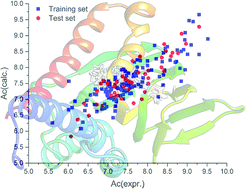Development of potential therapeutics for pain treatment by inducing Sigma 1 receptor antagonism – in silico approach†
Abstract
Sigma 1 receptor antagonism is deemed a promising pain treatment approach. This research paper outlines conformational-independent QSAR modeling for a range of compounds which serve as Sigma 1 receptor antagonists. The SMILES notation and the local molecular graph invariants were utilized as descriptors for building conformation-independent QSAR models, with the Monte Carlo optimization method serving as a model developer. For the purpose of testing the developed models’ quality, robustness, and predictability, various statistical methods were employed, including the ideality of correlation index. The results obtained were good. The molecular fragments accounting for the increase/decrease of the examined activity were defined and used for the computer-aided design of new compounds in order to determine their potential as analgesics. The final assessment of the developed QSAR models, as well as of the designed inhibitors, was performed with the use of molecular docking studies, highlighting exceptional correlation with the QSAR modeling results.



 Please wait while we load your content...
Please wait while we load your content...